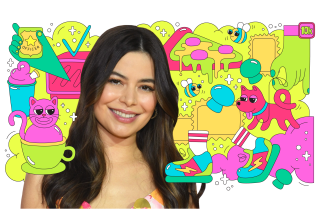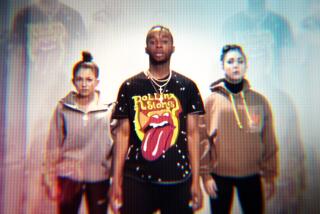Review: ‘Haters Back Off’ offers the funny origin story of Miranda Sings
Colleen Ballinger, who is YouTube famous as the character Miranda Sings — a character who is herself, and in a sense independently, YouTube famous — is bringing her alter ego to Netflix this week.
“Hey, guys! I’m a singer, dancer, actress … So I thought I’d post this video to YouTube to show everybody how good I am,” Miranda says to the camera (within the camera) by way of introduction to her imagined future fans, and to the viewers of “Haters Back Off,” the series Ballinger has co-created with brother Chris Ballinger. (Show runners Perry M. Rein and Georgia McCreery have “Friends” and “Wizards of Waverly Place” on their mutual resume.)
This is an origin story, and like “Saturday Night Live” sketches blown up to big-screen size (“The Blues Brothers,” “Wayne’s World,” “Superstar,” et al.), it faces the challenge of shaping a funny idea into a semblance of life, and succeeds.
As legions already know, the point — and the joke — is that the ferocious enormousness of Miranda’s self-regard, which blots out nearly everything around her, is inversely proportional to her talent — a Florence Foster Jenkins for our age.
Nevertheless, she takes adulation as her due, though her circle of admirers runs only as far as her Uncle Jim (Steve Little), who has also declared himself her manager; Patrick (Erik Stocklin), the smitten boy next door; and with pained love, from her mother, Bethany (Angela Kinsey). Sister Emily (Francesca Reale), painting landscapes in a corner of the garage, reading Sartre and Stephen Hawking, dreaming of escape, is the resident doubter, an outsider in a family of outsiders.
Being known on the Internet, once something of a putdown, is now understood as serious celebrity: Ballinger has more than 6 million subscribers to her Miranda Sings channel (more than a billion views) and more than 4 million to her wider-ranging PsychoSoprano channel. She also has nearly a million to her Colleen Vlogs channel, in which she talks about things she does on the other two channels and in her life, which itself is a thing partially performed on the Web.
“All the most famous people in the world started out on the Internet,” Miranda tells her mother, who doesn’t really know what that is. “Justin Bieber, Susan Boyle, that cat that fell off the table when it got scared.”
“I think you’re better than all those people,” says Bethany.
“And the cat?” Miranda angrily demands.
To become Miranda, Ballinger doesn’t do much but paint her lips and make a contorted mask of her face. She pushes her voice through her nose, adding a Bert Lahr Cowardly Lion vibrato when she sings. (As a singer, Ballinger knows what she’s doing, so that from moment to moment you go from thinking Miranda maybe can sing to realizing she can’t, and back and back again.) There are notes of Napoleon Dynamite, of Pee-wee Herman in a bad mood. With her cover-up fashions and awkward posture, she plays sometimes like a demented version of Sarah Hagan’s Millie on “Freaks and Geeks.”
Online, Miranda Sings is a game the audience plays along with, and participates in. Her obnoxiousness there is unbound by wider context; if anything, it’s validated by her measurable success and therefore something to celebrate: the outsider triumphant. But what might seem heroic or inspirational in the totality of hundreds of Internet videos or one of Ballinger’s stage shows strikes a different note here, where Miranda’s actions have consequences and other characters exist with needs and feelings of their own. (There are many needs and feelings expressed here.)
YouTube Miranda can always get a little worse; but for “Haters Back Off,” Miranda needs the possibility of getting just a little better. For the viewer, the question isn’t whether she’s going to get famous — clearly, she doesn’t deserve to, but if she does, fine, we have seen that story before — but whether a sliver of empathy will penetrate her self-obsession. The show draws you on with this promise.
Ballinger does well taking Miranda into this new world, in which she must be both ridiculous and, eventually, sympathetic; it doesn’t hurt, either, that she is surrounded by expert players. As Uncle Jim, with his desperate “five-phase plan for fame” and a devotion to Miranda just this side of creepy, Little is playing a character not a hundred miles from the one he played on “Eastbound and Down,” where he played the second fiddle to Danny McBride’s Kenny Powers. Stocklin is touching as Patrick; as Emily, the designated normal, Reale plays chords whose tones combine care and cruelty in equal, inextricable measure.
But it’s Kinsey, her hair dyed brown to match Ballinger’s, who owns the show. Wearing a wrist brace for her “undiagnosed fibromyalgia,” preparing for a casual meeting with a man she likes with “conversation cards” (“Hi, Keith,” “Acts surprised”), walking into church holding Emily by the pinky, her Bethany is full of sadness and hope and ragged dignity. She takes the series from a twisted lark to something deeper and grander, where even people who don’t know their YouTube from their Vimeo may find something valuable.
On Twitter @LATimesTVLloyd
More to Read
The complete guide to home viewing
Get Screen Gab for everything about the TV shows and streaming movies everyone’s talking about.
You may occasionally receive promotional content from the Los Angeles Times.







